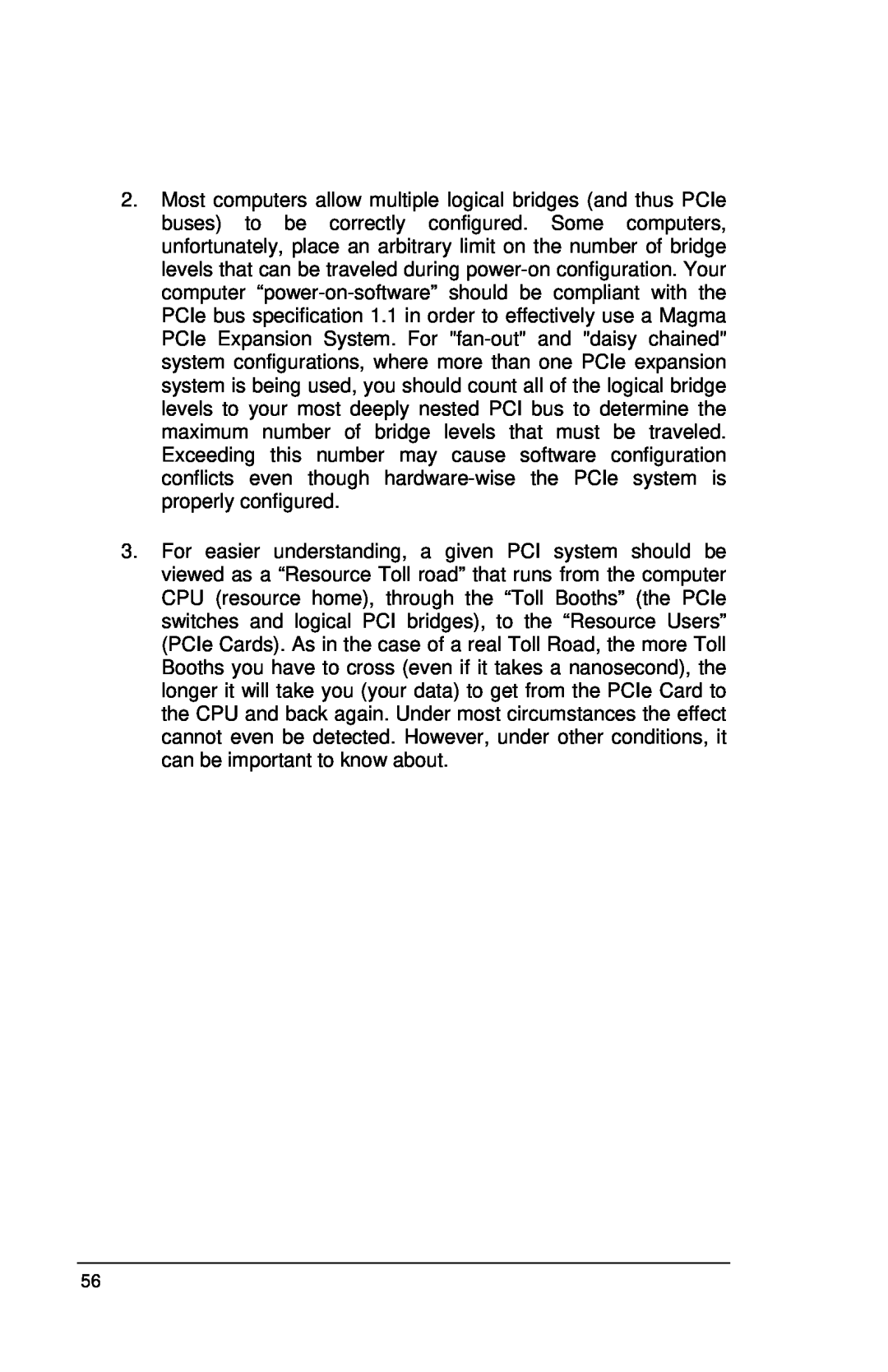Model EB7-x8 Model EBU Model EB7R-x8
ExpressBoxUniversal EBU PCI Express to PCI Express Expansion
Copyright 2009 Mission Technology Group, Inc. - DBA Magma
Limitation of Liability
Trademark References
VERIFY INSTALLATION
Table of Contents
HARDWARE INSTALLATION
CHAPTER 4 INSTALL CARDS AND DRIVES
TROUBLESHOOTING
CHAPTER 5 MODULAR SOLUTIONS WITH EBU
CHASSIS MAINTENANCE
CHAPTER 8 HOW TO GET MORE HELP
500Watt Power Supply Specifications
Page
Preface
Advisories
SafetyInstructions
When WorkingInsideaComputer
Protecting Against Electrostatic Discharge
Rack-Mount Instructions
General Specifications
Chapter 1 Introduction
PartsList
Pre-InstallationInformation
ToolsRequiredfor Installation
Item Qty
Chapter 2 Hardware Installation
STOP
Install PCI Express Host Card
Before you Begin
Attach Power and Expansion Cables
M A G M A STOP
Laptop Installation optional
the chassis along with the power cord
TDP side to Laptop
Picture B shows the Incorrect orientation
RechecktheInstallation
Applying Power Correctly
Starting Up
Hardware Check
You may now proceed to Chapter 3 Verify Installation
RackInstallations
Shutting Down
Windows Start Up
M A G M A
CHAPTER 3 Verify Installation
Windows
MacOSX
Expansion Slot Utility
Apple System Profiler
RedHat 9 Linux
Mapping Physical Slot locationsto port locations using lspci
Link Supported Speed 2.5Gb/s, Width x8, ASPM L0s L1, Port
Example lspci -vvv Output
Link Supported Speed 2.5Gb/s, Width x4, ASPM L0s, Port
Chapter 4 Install Cards and Drives
Remove PCI Express Expansion Chassis Cover
Cover Screws
Remove all of these screws in order to open the enclosure
Install 3rd PartyPCIe Cardsor Hard Drives
Installing 3rd Party PCIe Cards
Installing Hard Drives
System Should Be Up and Running
FinishingTouches
“Hot-Swappable”PCIeCardsoptional
Procedure for hot-un-plugging a PCIe plug in card
Double click on the applet
3. Select a device and click on the “Properties button”
8. A green LED, labeled P X PwrE where
Click on the Stop button of the dialog
Click on the OK button of the new dialog
corresponds to the slot number will begin
10. The LED should start flashing again
11. After 5-6 seconds the LED will stop flashing and remain on
PCIeExpansion Solutions with the EB7-x8
Digi Design Pro Tools
Video Card expansion solutions
High Throughput storage solutions
ATI HD4850
accessing our data
50% Reads 50% Writes
I/O Test type
Throughput MByte/sec
100% Reads
Chapter 5 Modular Solutions with EBU
Configuring a complete computer withEBU
Configuring EBU for I/OSharingbetweenmultiple Blades or Other Servers
Virtualization, Clusters, and EBU
ability of its chassis to allow for peer to peer communication between its slots as well as its ability to communicate with multiple Root Complex Port sources with its complementary Universal Host Adaptor product lends itself to very elegant and immensely cost effective I/O virtualization applications
Chapter 6 Chassis Maintenance
General Chassis Cleaning
Next, use a can of compressed air from your local computer store to blow out any dust that may have accumulated in the chassis fans
“Hot-Swappable”PowerSupply Optional
CleaningtheAirFilter
M A G M A
My Computer Can’t Find the PCIe Expansion System
Chapter 7 Troubleshooting
Locatethe Problem
ƒ When Nothing Works ƒ My PCIe Card Doesn’t Work
Check the DIP switch settings on the Magma Host Card
Windows
RedHat9 Linux
When Nothing Works
My Computer Hangs During Power Up
My PCIe Card Doesn’t Work
1. Shut down the computer followed by the Magma expansion chassis
Windows Error Codes
Support for 3rdPP Party PCIe Cards
Description/Action
Error Code
This code indicates that there is a problem with the 3rd
Party PCIe Card driver
Chapter 8 How to Get More Help
FrequentlyAskedQuestionsFAQ
Contacting Technical Support
Magma Debug Utility
2. Run Magnostic.exe
4. E-mail file to forums@magma.com
PCIScope Software Utility
Technical Support request at wwwH.magma.com/sTU upportUT.H
ReturningMerchandisetoMAGMA
Multiple PCIe Expansion System Configurations
Appendix A Need More PCIe Slots?
Page
Fan-Out
Verify your configuration
Daisy-Chaining
Combination Configurations
Fan -O ut D aisy-C hain C om bination C onfiguration
D aisy-C hain Fan -O ut C om bination C onfiguration
Power-On Sequence for Advanced Configurations
Troubleshooting AdvancedConfigurations
PCI e Card Conflicts
Page
Finding the Problem Card
MAC and Linux
APPENDIX B Compliance
FCC/CE/UL
IndustryCanada
AC INPUT
SAFETY
500Watt Power Supply Specifications
DC OUTPUT
MISCELLANEOUS
Magma 9918 Via Pasar, San Diego, CA 92126, USA
Phone 858 530-2511 Fax 858
09-09917-01- A Manual, USER, EB7-x8, ROHS
